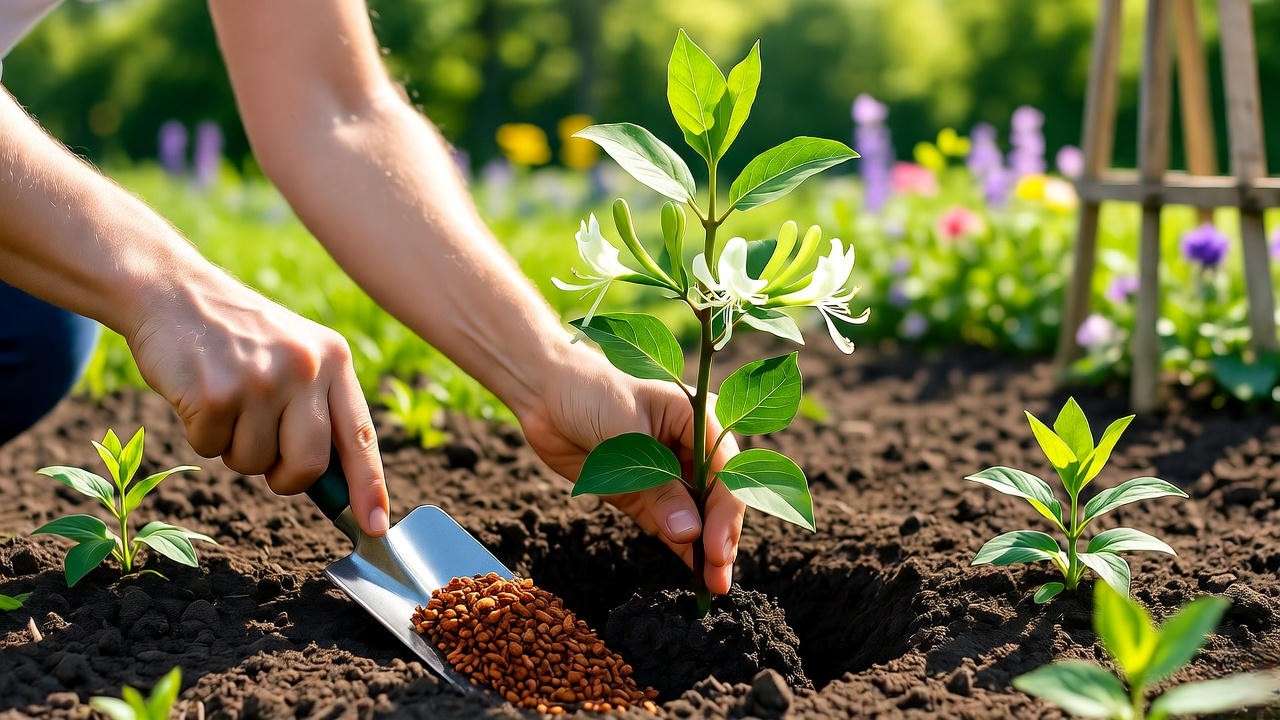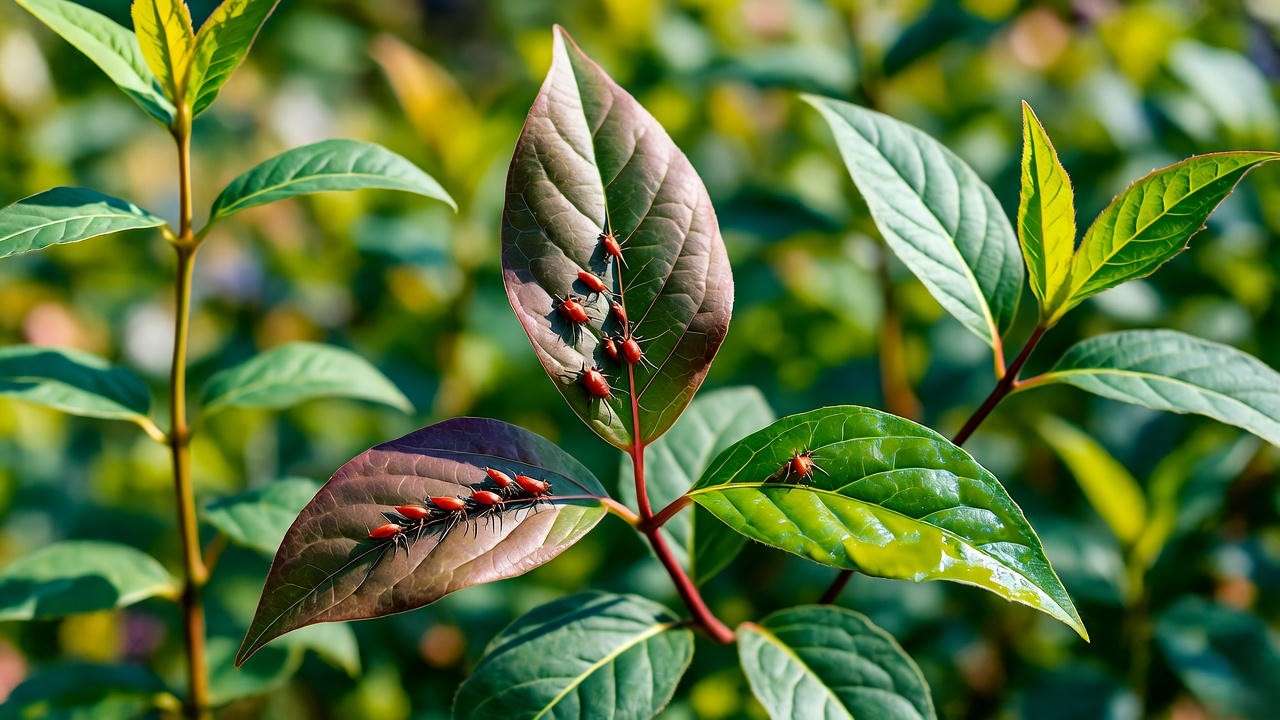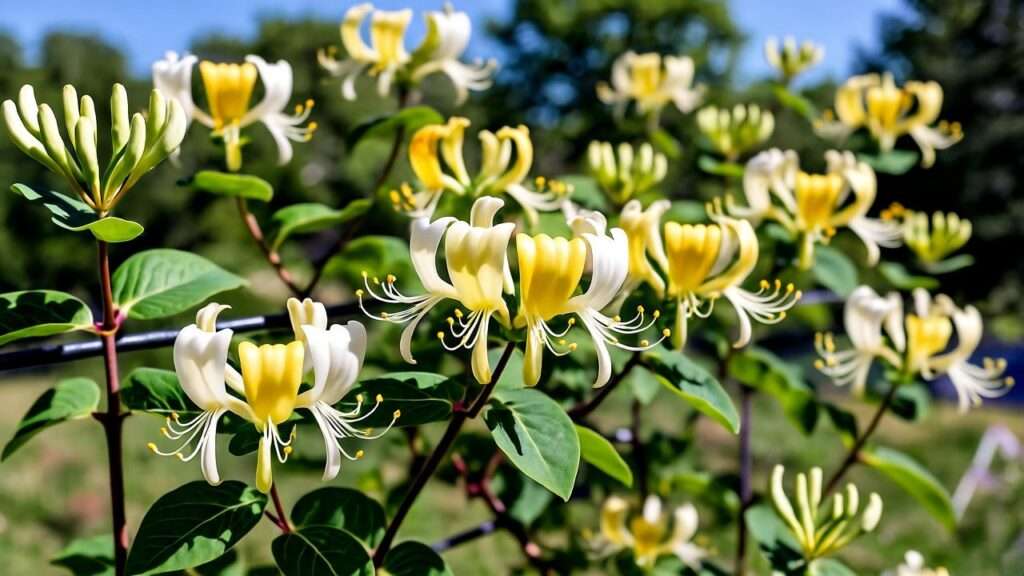Picture this: You step into your garden, and a wave of sweet, intoxicating fragrance envelops you, carried by cascades of vibrant yellow-white blooms. That’s the magic of Scentsation honeysuckle plants, a gardener’s dream for adding beauty, scent, and charm to any outdoor space. Whether you’re a seasoned horticulturist or a beginner with a passion for plants, this climbing vine is your ticket to a stunning, fragrant garden. In this comprehensive guide, we’ll walk you through everything you need to know to grow and care for Scentsation honeysuckle plants, from choosing the perfect spot to troubleshooting common issues. As a horticulture expert with over a decade of experience cultivating ornamental plants, I’ve poured my knowledge into this article to ensure your honeysuckle thrives. Get ready to transform your garden into a sensory paradise! 🌺
H2: What Makes Scentsation Honeysuckle Plants So Special? 🌟
H3: Overview of Scentsation Honeysuckle 🌱
Scentsation honeysuckle, scientifically known as Lonicera periclymenum ‘Scentsation’, is a deciduous climbing vine celebrated for its breathtaking beauty and fragrance. Unlike its invasive cousins, such as Japanese honeysuckle (Lonicera japonica), Scentsation is a non-invasive cultivar, making it a responsible choice for eco-conscious gardeners. Its tubular, creamy-white flowers, which deepen to golden yellow, bloom from late spring through summer, releasing a sweet, honey-like scent that’s strongest in the evening. This vine grows 6-12 feet tall, making it perfect for vertical gardening. Its long blooming season and ability to attract pollinators like bees, butterflies, and hummingbirds 🐝🦋 make it a standout in any landscape. Compared to other varieties, Scentsation offers a more intense fragrance and manageable growth, ideal for both novice and experienced gardeners.
H3: Benefits for Your Garden 🏡
Planting Scentsation honeysuckle plants brings a host of benefits to your garden. Aesthetically, their lush foliage and vibrant blooms add vertical drama to trellises, fences, or pergolas, creating a focal point in any outdoor space. The fragrance is a game-changer, transforming patios and seating areas into aromatic retreats, especially during warm summer evenings. Ecologically, these plants are pollinator magnets, supporting bees, butterflies, and hummingbirds, which are vital for a healthy ecosystem. Unlike invasive honeysuckles, Scentsation won’t overtake your garden or harm native plants, making it a sustainable choice. Its versatility allows it to thrive in various settings, from urban balconies to sprawling rural landscapes. Plus, its low-maintenance nature means you get maximum impact with minimal effort. 🌿
H2: How to Choose the Perfect Spot for Your Scentsation Honeysuckle 🌞
H3: Ideal Growing Conditions 🌍
To ensure your Scentsation honeysuckle plants flourish, start with the right growing conditions. These vines thrive in full sun to partial shade, requiring at least 4-6 hours of direct sunlight daily for optimal blooming. They prefer well-draining, fertile soil with a pH between 6.0 and 7.5, though they’re adaptable to slightly less ideal conditions. Scentsation honeysuckle is hardy in USDA Zones 4-9, making it suitable for a wide range of climates, from chilly northern winters to mild southern summers. Test your soil’s pH using a home kit to confirm it’s within the ideal range, and amend with compost if needed to boost fertility. Good air circulation is also key to preventing fungal issues, so avoid cramped or overly shaded spots. 🌞

H3: Site Selection Tips 🧭
Choosing the right location is critical for Scentsation honeysuckle’s success. Since these vines can grow 6-12 feet, ensure there’s enough space for them to climb and spread. A sturdy trellis, fence, or arbor is ideal, as the vine will need support as it matures. Position your honeysuckle near seating areas or walkways to enjoy its fragrance, but avoid planting too close to structures where airflow is limited. For urban gardeners, consider placing it near a balcony railing to maximize scent impact. To prevent overcrowding, keep it at least 3-4 feet from other plants. Expert tip: Before planting, check your site’s drainage by digging a hole and filling it with water—if it doesn’t drain within a few hours, amend the soil with sand or gravel. 🪴
H2: Step-by-Step Guide to Planting Scentsation Honeysuckle 🌱
H3: When and How to Plant 📅
Timing and technique are everything when planting Scentsation honeysuckle. The best time to plant is early spring or fall, when cooler temperatures help roots establish without stress. Start by digging a hole twice as wide and as deep as the root ball. Mix the excavated soil with compost to enrich it, then place the plant so the top of the root ball is level with the soil surface. Backfill the hole, tamp gently, and water thoroughly to settle the soil. Space multiple plants 3-6 feet apart to allow for growth. Water consistently for the first few weeks to encourage strong root development. Expert tip: Soak the root ball in water for 10-15 minutes before planting to reduce transplant shock. 🌿

H3: Supporting Structures 🏗️
Scentsation honeysuckle’s climbing habit requires a sturdy support structure. Trellises, pergolas, fences, or obelisks work beautifully, but ensure they’re strong enough to handle the vine’s mature weight. Install the support before or during planting to avoid disturbing roots later. For a trellis, choose one at least 6 feet tall to accommodate growth. If using a fence, ensure it’s well-anchored and made of durable material like wood or metal. For a whimsical touch, consider an arched arbor to create a fragrant garden entrance. Secure the vine loosely to the structure with soft ties, allowing room for growth. Regularly check ties to prevent them from cutting into stems as the plant matures. 🏡
H3: Container Planting for Small Spaces 🪴
Don’t have a large garden? Scentsation honeysuckle thrives in containers, making it perfect for balconies or patios. Choose a pot at least 18-24 inches in diameter with drainage holes to prevent waterlogging. Fill it with a high-quality potting mix blended with compost for nutrients. Place the container in a spot with 4-6 hours of sunlight, and provide a small trellis or stake for the vine to climb. Water more frequently than in-ground plants, as containers dry out faster. In colder climates, wrap the pot in burlap during winter to protect roots. Expert insight: Refresh the top layer of soil annually to maintain fertility in potted honeysuckles. 🌺
H2: Essential Care Tips for Thriving Scentsation Honeysuckle 🌿
H3: Watering Needs 💧
Proper watering is crucial for Scentsation honeysuckle, especially in its first year. Water deeply once or twice a week, ensuring the soil stays moist but not soggy. Established plants are drought-tolerant but benefit from occasional deep watering during dry spells. Check for signs of overwatering (yellowing leaves, root rot) or underwatering (wilting, dry leaves), and adjust accordingly. Use a soaker hose or drip irrigation for efficient watering that targets roots. In hot climates, mulch around the base to retain moisture. Expert tip: Water in the morning to reduce evaporation and minimize fungal risks. 💦

H3: Fertilizing for Optimal Growth 🌾
To keep your Scentsation honeysuckle plants thriving, fertilize them thoughtfully. In early spring, apply a balanced 10-10-10 fertilizer or a slow-release organic option like compost or well-rotted manure to encourage healthy growth and abundant blooms. Follow up with a second application in mid-summer to sustain flowering. Avoid over-fertilizing, as excessive nitrogen can lead to lush foliage at the expense of flowers. Always water thoroughly after fertilizing to help nutrients reach the roots. For organic gardeners, fish emulsion or seaweed extract can provide a nutrient boost without synthetic chemicals. Expert insight: Test your soil annually to ensure nutrient levels are balanced, as deficiencies can reduce bloom quality. 🌱
H3: Pruning for Health and Beauty ✂️
Pruning is essential to maintain the shape, health, and blooming potential of Scentsation honeysuckle. The best time to prune is late winter or early spring before new growth begins. Remove dead, damaged, or tangled stems to improve air circulation and prevent disease. To encourage bushier growth, cut back one-third of the oldest stems to the base, stimulating new shoots. For mature plants, light pruning after flowering can keep the vine tidy. Always use clean, sharp pruning shears to avoid spreading pathogens. Expert tip: Sterilize your tools with rubbing alcohol between cuts to ensure plant health. 🧼 This keeps your honeysuckle vibrant and well-structured year after year.
H3: Mulching and Winter Care ❄️
Mulching is a game-changer for Scentsation honeysuckle, helping retain moisture, regulate soil temperature, and suppress weeds. Apply a 2-3 inch layer of organic mulch, such as bark, straw, or wood chips, around the base, keeping it a few inches from the stems to prevent rot. Refresh the mulch annually in spring. In colder climates (USDA Zones 4-5), protect the roots in winter by adding an extra layer of mulch or wrapping the base with burlap. If grown in containers, move pots to a sheltered area or insulate them to prevent root freezing. Expert insight: Mulching also enriches the soil as it decomposes, reducing the need for frequent fertilizing. 🌿
H2: Common Problems and Solutions for Scentsation Honeysuckle 🩺
H3: Pests and Diseases 🐛
While Scentsation honeysuckle is relatively hardy, it can face pests like aphids, spider mites, or powdery mildew. Aphids, small sap-sucking insects, can be controlled with a strong blast of water or insecticidal soap. Spider mites, often seen in dry conditions, respond well to neem oil applications. Powdery mildew, a white coating on leaves, thrives in humid, poorly ventilated areas—improve air circulation and apply a fungicide if needed. Regular inspections catch issues early. Expert tip: Encourage natural predators like ladybugs to keep pest populations in check naturally. 🐞 For severe infestations, consult your local extension service for region-specific advice.

H3: Troubleshooting Growth Issues 🌿
If your Scentsation honeysuckle isn’t performing as expected, investigate common culprits. Yellowing leaves may indicate overwatering, poor drainage, or nutrient deficiencies—check soil moisture and test for pH imbalances. Sparse blooms often result from insufficient sunlight or improper pruning; ensure 4-6 hours of sun and prune correctly. Stunted growth could signal compacted soil or root-bound containers—loosen soil or repot as needed. FAQ example: “Why isn’t my honeysuckle blooming?” Likely causes include too much shade or over-fertilizing with nitrogen-heavy products. Adjust conditions and monitor progress. Expert insight: Patience is key—newly planted honeysuckles may take a year to establish before blooming profusely. 🌸
H2: Creative Ways to Use Scentsation Honeysuckle in Your Garden Design 🎨
H3: Landscaping Ideas 🏞️
Scentsation honeysuckle’s versatility makes it a star in garden design. Use it to cover arbors or pergolas, creating shaded, fragrant retreats for outdoor gatherings. Train it along fences for a living privacy screen that’s both functional and beautiful. Pair it with companion plants like roses, clematis, or lavender to create a vibrant, pollinator-friendly border. For small gardens, grow it on a decorative obelisk as a vertical focal point. Its cascading growth also works well in mixed shrub beds, adding height and texture. Example: A homeowner in Virginia transformed their backyard by training Scentsation honeysuckle over a pergola, creating a cozy, scented seating area. 🪑

H3: Enhancing Outdoor Living Spaces 🪑
Maximize the sensory appeal of Scentsation honeysuckle by placing it near patios, decks, or garden benches, where its evening fragrance can be fully enjoyed. A trellis near a window allows the scent to waft indoors, enhancing your home’s ambiance. For urban gardeners, a container-grown honeysuckle on a balcony railing adds charm without sacrificing space. Combine with string lights or lanterns for a magical evening effect. Expert tip: Position the vine where it gets morning sun and afternoon shade in hot climates to prolong bloom life. This strategic placement ensures your outdoor space feels like a fragrant oasis all season long. 🌺
H2: Environmental and Ecological Benefits of Scentsation Honeysuckle 🌎
Scentsation honeysuckle is a boon for eco-conscious gardeners. Its nectar-rich flowers attract pollinators like bees, butterflies, and hummingbirds, supporting local biodiversity and aiding food crop pollination. Unlike invasive honeysuckle varieties, Scentsation is non-invasive, ensuring it won’t disrupt native ecosystems. Its low water and maintenance needs make it a sustainable choice for water-wise gardens. By providing habitat and food for wildlife, it contributes to a healthier garden ecosystem. Expert insight: Planting Scentsation honeysuckle near vegetable gardens can boost pollination rates, leading to better yields of crops like tomatoes or squash. 🌿 This makes it a win-win for beauty and environmental impact.
H2: FAQs About Scentsation Honeysuckle Plants ❓
- Is Scentsation honeysuckle deer-resistant? Yes, it’s moderately deer-resistant, though hungry deer may nibble in lean seasons. Use repellents or fencing for extra protection.
- How fast does Scentsation honeysuckle grow? It grows 1-2 feet per year, reaching maturity in 2-3 years under ideal conditions.
- Can it grow in shade? It tolerates partial shade but needs 4-6 hours of sun for best blooms.
- How do I control pests naturally? Use neem oil or introduce beneficial insects like ladybugs.
- Does it require a lot of maintenance? No, it’s low-maintenance once established, needing only occasional watering and pruning.
- Can it be grown in containers? Yes, use a large pot with good drainage and a trellis for support.
- Is it safe for pets? Scentsation honeysuckle is non-toxic to dogs and cats, but avoid ingestion.
H2: Conclusion: Transform Your Garden with Scentsation Honeysuckle 🌺
Scentsation honeysuckle plants are a gardener’s dream, blending stunning blooms, irresistible fragrance, and ecological benefits into one easy-to-grow package. Whether you’re creating a fragrant pergola, a pollinator haven, or a container garden, this vine delivers unmatched beauty and charm. By following this guide’s expert tips on planting, care, and design, you’ll ensure your honeysuckle thrives for years. Start planting this season and watch your garden transform into a sensory masterpiece! Share your Scentsation honeysuckle success stories or questions in the comments, and explore our other plant care guides for more inspiration. Authored by a horticulture expert with 10+ years of experience in ornamental gardening. 🌸













